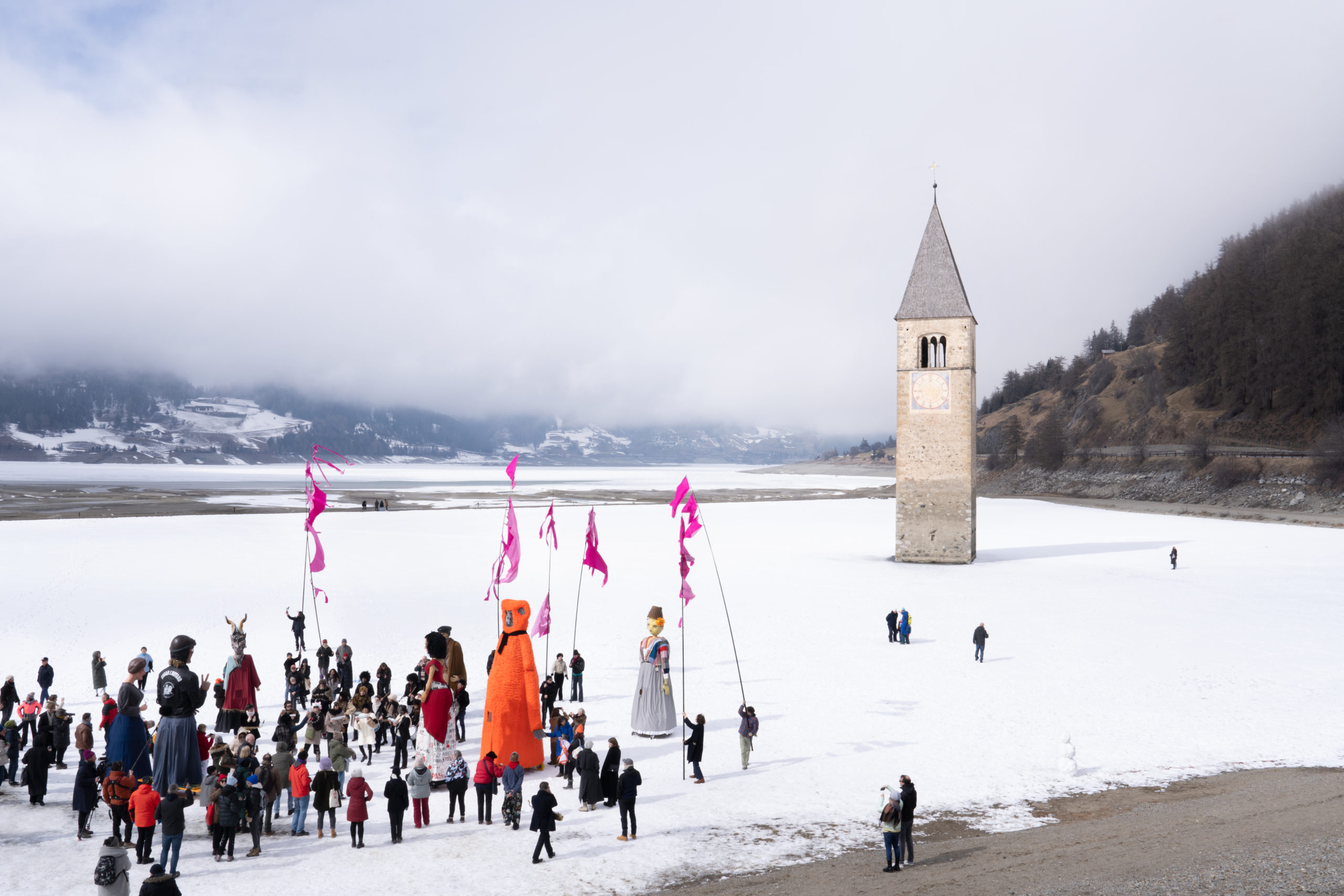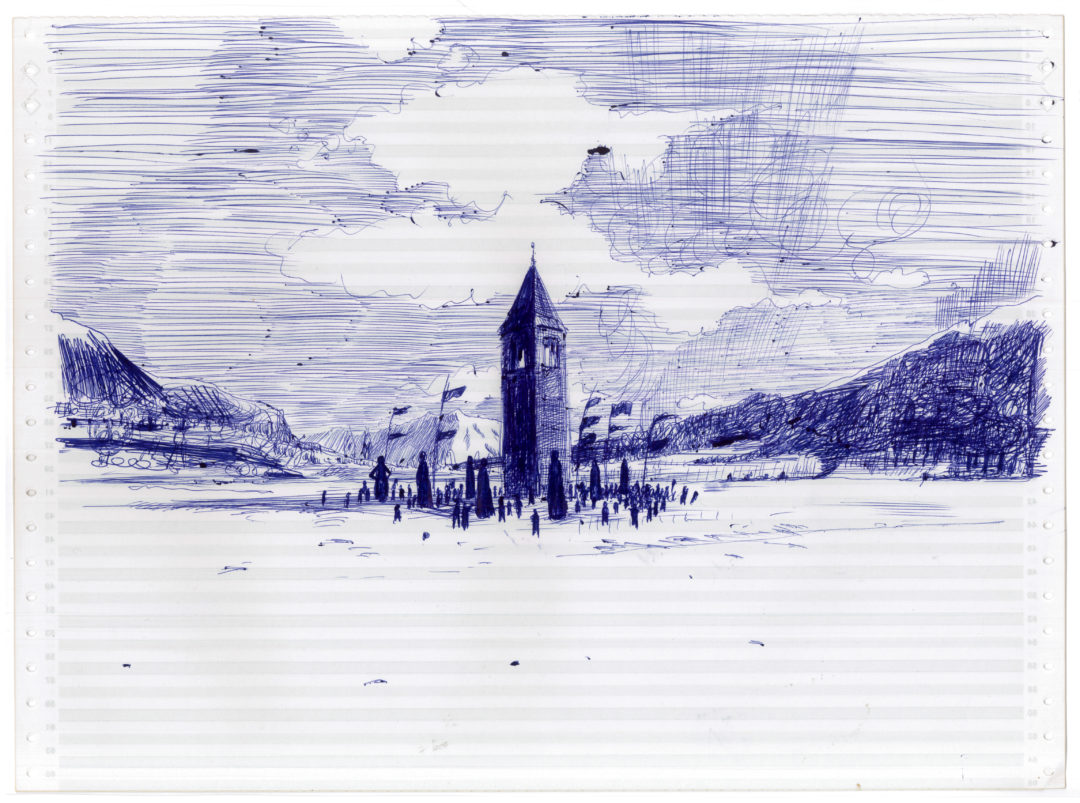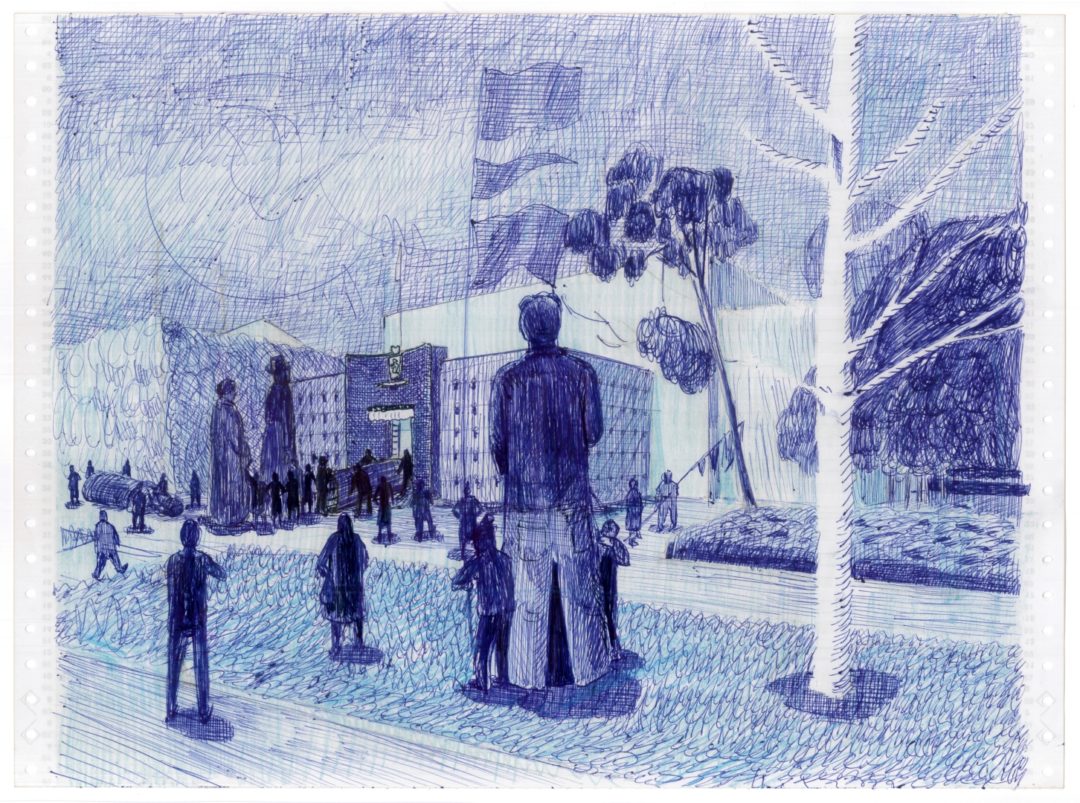Petticoat Government

Belgian Pavilion, Venice Biennale 2024
20 April ◊ 24 November 2024
With Denicolai & Provoost, Antoinette Jattiot, Nord, Spec uloos
And the Young Curators, the Young Storytellers, the giant and giantess communities, Akerbeltz, Babette, Dame Nuje Patat, Edgar l’motard, Erasme, Julia, Mettekoe
At midday on 9 March 2024, seven giants stand on the frozen lake of Resia, on the natural border of the Alps. Behind their immense bodies emerges the unreal silhouette of a bell tower hemmed in by the ice; the only vestige still visible of the village of Curon Venosta, submerged in the 1950s by the construction of a dam under Mussolini. On this fog-shrouded stage, the seven giants dance to the rhythm of a tiny brass band set up at their feet: they have just been introduced.
Not far away, seven people cross and uncross their arms around a large flag, which they unfold in a choreography guided by the patterns punched into it. Soon the whole fabric is unfurled, an immaculate white that mimics freshly fallen snow. Their fourteen hands spread it out in a single movement on a table set up by the lake, soon to be filled with large dishes, glasses and bread, which at least three hundred other little hands come to pick at.
When passers-by stop and ask about this strange picnic, they are told:
– We’re representing Belgium at this year’s Venice Biennale, and we’re on our way to our Pavilion.
Let’s go back to April 2023, when the results of the call for projects by the French-speaking Ministry of Culture (1) to represent Belgium at the 60th Venice Biennale are published. The selection process involved a public procurement procedure, which immediately suggests a link between, on the one hand, the way in which such a procedure requires attention to be paid to the project and the artist as a whole; and, on the other hand, the choice of a horizontal working method supported by the artists within the selected project.

“Petticoat Government” is a “choral work” (DP) marked by the desire to weave together identities and skills often outside the artistic sphere, with narrative tools and devices nourished by the artistic and curatorial practices of the seven members of a collective specially formed for the project: the artist duo Simona Denicolai & Ivo Provoost, the author and curator Antoinette Jattiot, the architect duo Nord (Pauline Fockedey and Valentin Bollaert) and Spec uloos (Pierre Huyghebaert and Sophie Boiron).
Its title, “Gouvernement des jupons”, refers to the reversal of power relations within the court of Louis XV under the influence of Madame de Pompadour, the King’s favourite. It’s a way of announcing the ambition behind the project: to blur the boundaries and hierarchies in place, the authority and codes of the institution, by responding to them with the creation of a “scenario” that extends far beyond the exhibition, both in space and in time. A travel scenario in which what will be visible in the Pavilion unfolds under the sign of a halt, of a temporary calm, like a parenthesis left for the characters to rest between two chapters of the story.
There are seven characters: Akerbeltz, Babette, Dame Nuje Patat, Edgar the biker, Erasmus, Julia and Mettekoe. Their stories began before the birth of the Petticoat Government (PG) collective, and will continue afterwards. These characters are giants, beings of folklore, borders and communities, re-enacting on their own scale the work and festivities to be carried out to represent a particular social group – and that’s what the Venice Biennale is all about too. The PG collective selected the seven giants, with the support and expertise of ‘giantologist’ Tristan Sadones, precisely for their ability to convey imaginations and identities that are extremely situated from a social, historical, geographical and often political point of view; but also for their ability to embody, within this highly contextualised identity, a form of universality.
Akerbeltz, for example, is a figure of the frontier, half-man, half-animal. He comes from the pro-independence village of Mutriku in the Basque Country, where he is presented at public events, particularly political demonstrations. In Resia, instead of the badges that are usually attached to his tunic, he wears baby teats as rings on each of his fingers. Edgar, another example, is the one who crosses, who transgresses, inspired by a real character, a smuggler who transported tobacco in the double bottom of the tank of his motorbike between France and Belgium. This giant has been carried since 2007 by a group of bikers from Steenvoorde (French Flanders), and is the first to take to the ice on 9 March. Babette, finally, is also inspired by an important figure in the Tourcoing district where she comes from. More precisely, it is inspired by a figure from the trade union and workers’ movement, embodied by a dressmaker who died a few years ago. It was created only a year ago, modelled by several hands in the MJC workshops, and its clothes made by the seamstresses who succeeded her. It made its first official appearance that Saturday, on the frozen lake.
Festivities were organised for the departure of each giant to her community, and each trip was reported in the local newspapers in inserts designed by the PG collective. On 7 March, the seven giants left Brussels by lorry for Resia. The following day, several members of each of the communities took part in the artistic team’s convoy. During the journey, some of them spoke of their giants as if they were absent friends, travelling companions who were making the journey on their side. They call them by their first names, and have fun imagining what they might be doing if they had already arrived. Together, but each in their own way, they stir up trouble in a reality where the imaginary makes inroads – which already reveals the narrative potential of the project, the appearance of narratives that seem to be co-constructed, but which above all come back to these communities, to what they have projected into these beings designed to represent them in a big way. So how do we take hold of such narratives and deploy them, move them around, reinvest them collectively without emptying them of their substance?
This is a question entirely taken on by the PG collective, who answer it by inviting a third party into the equation. In doing so, they have made their own a feature of the call for projects to which they responded, which made it compulsory for the first time this year for young curators still in training to be involved in the construction of the exhibition and its mediation at the Belgian Pavilion in Venice (2). Petticoat Government thus entrusts these young people with writing the stories of the giants and transmitting them orally to the public at the pavilion.

Courtesy Petticoat government (Denicolai & Provoost · Antoinette Jattiot · Nord · Spec uloos) & LMNO Bruxelles.
The scope of these stories also operates from the point of view of the written word, in a singularly high-performance editorial dimension : just after the picnic on the frozen lake of Resia, the giants made a final stop at the Gazetta printing works in Padua, where gigantic newspapers (380 x 578 mm) were printed under their benevolent gaze, mimicking the quotidiano di grande formate. These newspapers, published in four languages, are freely available in the pavilion, where you can also print out the full catalogue of the project on request, which includes a number of scientific contributions (3) and notes written by the Young Curators and Young Storytellers… All this is accompanied by the sound of a few remanent drums (4), played from time to time in the space, and always under the watchful eye of the giants from their high posts – the space on the ground being left to the steps we wish to take, to our time for reading, resting and stopping.
You get the feeling that all the devices that make up the body of the exhibition are constantly gesturing towards what has existed outside the walls of the pavilion, and will continue to exist afterwards, since two new chapters are due to be held at the BPS22 in Charleroi, in spring 2025, and at the Frac Grand Large in Dunkerque, in autumn 2025 (dates to be confirmed). The whole scenario would then have to be conceived as a single performance, on a gigantic scale, of which these diaries would be witness objects. Each time they are seized, each time they are read by anyone who can be seen manipulating these immense pages within the pavilion, they would be a new activation: a gesture that participates, on its own scale, in the scenario like a spontaneous scene, but one that has always been anticipated by those who have thought up the whole story, who have always already told it. From then on, only the infinite variation of collective, personal and intimate receptions of these stories could escape this scenario, or even go beyond it. And even if it did, wouldn’t this overcoming be its perfect extension, as the actualisation of a power of propagation and interpretation of the tales, a power deliberately entrusted to the greatest number?
What is at stake here, with its many mise en abîmes, is this ultimate question: to what extent is it possible to decompartmentalise the place of the work and that of life (through which the presences that surround those of the giants infiltrate, through which the jubilation, skills and popular cultures are summoned)?
“It’s at the heart of our work to postulate that everything is already there,” say Denicolai & Provoost, members of the PG collective, in an interview (5). Does this mean that for “Petticoat Government”, the seven artists have concentrated their intervention on this primary gesture of gathering, by simply summoning beings and objects that were already there, but not in the same place?
Starting with the seven of them coming together to form this collective, and then deploying the great technical skill with which they created an entourage for this work, not only through multiple collaborations, but also through invitations: to share the giant’s journey, their meals, their parties. The artists’ gesture can therefore be seen first and foremost, and perhaps above all, as a gesture of hospitality. In fact, it was certainly during the stopover in Resia, at the very moment when the seven members of the collective unfolded a huge tablecloth to the sound of drums, under the gaze of humans and giants, that we said to ourselves: “They are the hosts of all this.”
It’s a gesture that overturns hierarchies and institutional codes in the process of creating a work of such magnitude, but one that is nonetheless highly relevant to the subject of this 60th Venice Biennale: Stranieri Ovunque – Foreigners Everywhere, if we remember that the word host designates “the one who welcomes and the one who is welcomed, and this is an immemorial discovery, civilisation itself […]” (6).
This tablecloth, which is the very embodiment of the act of receiving – the same word here also designates the act of offering – nevertheless shows us that the artists’ gesture is not limited to gathering what is already there. The object is designed and produced to summon up each of the project’s time-spaces, and activated in a performance that brings together the bodies of the seven members of the collective on a horizontal axis defined by the height of their hands and their shared movements.
Firstly, a flag raised in Leuven (Belgium) on 9 December 2023 to inaugurate the project. Its length corresponds to the maximum dimension that prevents it from hitting the façade of the neighbouring school. In Venice, for the duration of the exhibition, it will be a curtain, its width corresponding to the size of the pavilion’s side room. The fabric is perforated, dotted diagonally, drawing lines that serve as a guide for a seven-person fold. Between each of these folds, traces of food and spilt glasses will appear, like fragments of the day of 9 March 2024. In a dizzying interplay of scales, from the immensity of a flag flying in the wind, of this table set on a frozen lake, of the crowd of people involved and invited, of the guests going back and forth, this tablecloth carries like any other the minutiae of the lunch: the smallest traces of the smallest bites and the fingers of all the little hands that sat at the table on the day when the giants met for the first time.
1 In Belgium, the National Pavilion is supported alternately by the Flemish Community (Francis Alÿs Pavilion in 2022) and the Wallonia-Brussels Federation (“Petticoat Government” this year).
2 2024 will see the third edition of the Young Curators Programme (YCP), a scholarship programme designed to offer opportunities to young curators from Belgium working in the Wallonia-Brussels Federation and Flanders. The Young Storytellers are also taking part, this time young artists still in training at schools in French-speaking Belgium and Northern France.
3 To date, the press kit confirms the contributions of researchers in sociology and anthropology, and art critics such as Alexis Zimmer, Silvia Mesturini, Stephen Wright, Elisabeth Lebailly and Maximilien Atangana.
4 Performances by the Salamba and Philharmonix brass bands in Resia, 9 March 2024.
5 Pascale Viscardy, “Are we in the show?”, interview, Flux Magazine, 2021.
6 Barbara Cassin, La Nostalgie. Quand donc est-on chez soi, Paris, Autrement, 2013
______________________________________________________________________________
Head image : Picnic Party at Lago di Resia, Petticoat Government, Pavillon Belge pour le pavillon belge à la 60° exposition d’art de la Biennale di Venizia 2024. Courtesy Petticoat Government (Avec Denicolai & Provoost, Antoinette Jattiot, Nord, Speculoos). Photo : Lola Pertsowsky
- From the issue: 108
- Share: ,
- By the same author: Design Sediments at Huidenclub, Rotterdam, Gina Folly at la synagogue de Delme,
Related articles
Streaming from our eyes
by Gabriela Anco
Don’t Take It Too Seriously
by Patrice Joly
Déborah Bron & Camille Sevez
by Gabriela Anco

